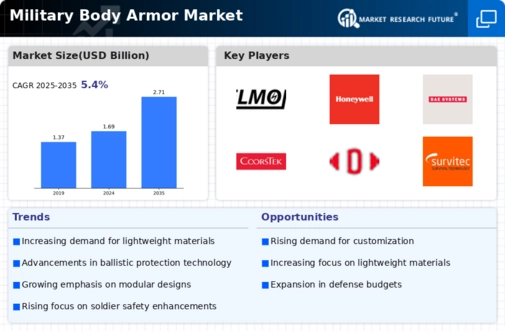Market Share
Military Body Armor Market Share Analysis
In the highly specialized realm of the Military Body Armor Market, companies strategically employ a range of market share positioning strategies to gain a competitive edge and secure a substantial share of the industry. One prevalent strategy is differentiation, where companies focus on developing advanced and specialized body armor technologies to distinguish themselves from competitors. This may involve innovations in lightweight materials, increased flexibility, and enhanced protection capabilities, catering to military and law enforcement agencies seeking cutting-edge solutions for personnel protection. By emphasizing these unique features, companies aim to attract clients looking for state-of-the-art military body armor, positioning themselves as leaders in the evolving field of personal protection for defense and security forces.
Cost leadership is another crucial strategy within the Military Body Armor Market, as companies strive to become the primary providers of cost-effective solutions. Achieving cost leadership involves optimizing manufacturing processes, sourcing materials strategically, and offering competitively priced body armor without compromising on performance or durability. This strategy appeals to defense organizations and security forces facing budget constraints, which require efficient protection solutions for personnel in the field. By providing cost-effective options, companies can broaden their customer base and secure contracts in a market where affordability is a significant consideration.
Market segmentation plays a fundamental role in market share positioning within the Military Body Armor Market. Companies analyze the diverse needs of various user segments, including infantry, special forces, and law enforcement, tailoring their body armor offerings to specific requirements. This segmentation could involve developing specialized armor for different threat levels, incorporating modular components for mission-specific adaptability, or creating solutions tailored to specific operational environments. By understanding and addressing the distinct needs of different end-users, companies can effectively target their marketing efforts, creating a stronger foothold in specific niches within the broader market.
Strategic partnerships and collaborations are key components of market share positioning within the Military Body Armor Market. Companies often form alliances with defense contractors, research institutions, or government agencies to enhance the development and performance of their body armor solutions. These collaborations may involve joint research and development initiatives, testing and certification partnerships, or integration with other military technologies. Such partnerships not only strengthen a company's market position but also contribute to advancements and innovation in the field of military body armor, ensuring the highest standards of protection for military and law enforcement personnel.
Geographical expansion is a notable strategy for market share positioning, where companies strategically enter new markets to tap into emerging opportunities. This could involve establishing partnerships with local defense contractors, participating in international defense exhibitions, or adapting products to meet specific regional regulations and operational requirements. By expanding their geographic reach, companies aim to increase their market share and adapt their military body armor solutions to the unique challenges and threats in different parts of the world.


















Leave a Comment